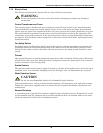
Component Operation and Maintenance, Checks and Adjustments
50
7.2 Filters
Filters are usually the most neglected item in an environmental control system. To maintain efficient
operation, they should be checked monthly and changed as required. Because replacement intervals
vary with environmental condition and filter type, each unit is equipped with a filter clog switch. This
warns of restricted airflow through the filter compartment by activating the Change Filter alarm.
• Turn power off before replacing filters.
• Deluxe filters can be replaced from either end by opening the end doors. On large chilled
water units, filters can be replaced from the front. Removing the middle filters will allow you
to remove the end ones. Install the new end filters first, then the middle ones.
• Replacement filters are commercially available in several efficiencies. For Deluxe units, refer
to the Technical Data Manual or other documentation for filter sizes.
• After replacing the filter(s), test the operation of the filter clog switch. Turn the adjusting
screw counter clockwise to trip the switch — this will energize the Change Filter alarm. To
adjust the switch proceed as follows: With the fan running, set the switch to energize the light
with clean filters. The unit panels must all be in place and closed to accurately find this point.
Then turn the adjusting knob 1 turn clockwise, or to the desired filter change point.
7.3 Blower Package
Periodic checks of the blower package include: belt, motor mounts, fan bearings, and impellers.
These units are manufactured with factory supplied adjustable motor sheaves. Due to variations in
applications, a fixed motor pulley may be desired and can be substituted for the adjustable sheave
after obtaining and confirming the desired air flow. This will reduce vibration and wear on the belts
and pulleys. Consult the factory for more information.
7.3.1 Fan Impellers and Bearings
Fan impellers should be periodically inspected and any debris removed. Check to see if they are
tightly mounted on the fan shaft. Rotate the impellers and make sure they do not rub against the fan
housing.
Bearings used on the units are permanently sealed and self-lubricating. They should be inspected for
signs of wear when belts are adjusted. Shake the pulley and look for movement in the fan shaft. If any
excessive movement is noticed, bearings should be replaced. However, the cause of the wear must be
determined and corrected before returning the unit to operation.
7.3.2 Belts
The drive belt should be checked monthly for signs of wear and proper tension. Pressing in on belts
midway between the sheave and pulley should produce from 1/2" to 1" (12 to 25 mm) of movement.
Belts that are too tight can cause excessive bearing wear.
Belt tension is adjusted by raising or lowering the fan motor base. To adjust the motor, loosen (but do
not
remove) the four motor mounting bolts. Turn adjustment bolt(s) on motor mounting base to adjust
belt tension or to raise motor to remove belts. Tighten motor bolts after adjustment. If belt appears
cracked or worn, it should be replaced with a matched belt (identically sized). With proper care, a belt
should last several years.
NOTE
After adjusting or changing belts, always be certain that motor base nuts are tightened. Loose
mounts will produce vibration that may damage the unit.


















